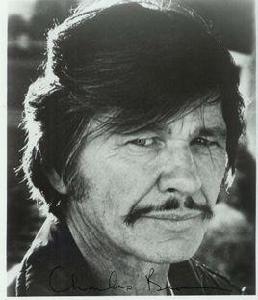早年經歷
查爾斯·布朗森,經典銀幕硬漢演員。他的標誌性特徵是他那飽經風霜好像一直沒有變過的面龐,以至於有的電影評論家稱“他就是克拉克·蓋博在烈日下被暴曬了幾個時辰的版本”。查爾斯·布朗森本名查爾斯·布辛斯基,1921年生於賓夕法尼亞州的礦工家庭,家裡共有15個孩子。雙親都在賓州辛勤工作。母親瑪麗出生於賓州,父親文森特是一名煤礦工人,亦是立陶宛移民。
查爾斯高中畢業後就隨父親來到礦產工作(在礦場工作的經歷導致他患上了密閉空間恐懼症)。二戰爆發後,他回響號召參軍入伍同法西斯作戰,當了一名飛機機槍手。復員後,藉助1944年的《軍人安置法案》進入學校學習美術(美術從此成為了他畢生的興趣),之後他在加州帕薩迪納劇院找到一份工作。查爾斯的一名老師非常欣賞這位年輕人的才華和個性,於是把他引薦給了導演亨利·海瑟威,使得查爾斯於1951年貢獻出了他的銀幕處子秀。
通過這次經歷,查爾斯正式開始了他的影壇生涯,儘管一開始他也和許多人一樣在片場跑龍套。
演藝經歷
1953年,查爾斯出演了文森特·普萊斯主演的3D驚悚電影《恐怖蠟像館》(1953),他扮演的邪惡助手一角給觀眾留下了深刻印象。在早年參演的作品中,他經常在銀幕中一展其壯碩的身材,展示其高不可攀的男子氣概。
早年他在各類動作電影中摸爬滾打,其中的一些表演受到了一些電影評論家的好評,比如黃金篷車大作戰(1954)和飛箭(1957)。1958年,查爾斯出演了獨立電影導演羅傑·科爾曼的低成本黑幫電影《機關槍凱利》(1958),廣受好評。接著又主演了電視劇集《Man with a camera》。漸漸地,在六十年代,查爾斯樹立起來了他的銀幕表演基調——沉默寡言,只靠行動說話。
1960年,查爾斯·布朗森出演了約翰·斯特奇斯導演的《豪勇七蛟龍》(1960),扮演一名愛爾蘭和墨西哥混血的槍手Bernardo O'Reilly。影片上映後廣受好評。三年後,約翰再次同查爾斯合作了當年的一部大製作二戰題材電影《大逃亡》(1963)(史蒂夫·麥奎因主演),他在其中扮演“地鼠”Danny Velinski。在主演了幾部電影之後,查爾斯再次回歸軍事題材電影,在1967年同李·馬文和歐內斯特·博格寧出演了爺們兒氣息爆表的《十二金剛》。歐洲觀眾對他
簡單粗暴的銀幕形象很是欣賞。後來查爾斯·布朗森接連參演了幾部動作片類型的電影,例如1968年上映的《雙虎將大追蹤》,賽爾喬·萊翁內西部片經典《西部往事》(1968),與時任妻子吉爾·艾蘭德搭檔出演的《雨中的乘客》(1970),並且在1971年,他還和日本著名演員三船敏郎和另一位知名銀幕硬漢阿蘭·德龍合作出演了《龍虎群英》(1970)。
在查爾斯出演了幾部歐洲電影之後,美國觀眾更願意看到他回歸美國大眾的視野。的確查爾斯·布朗森在七十年代早期又成為了美國觀眾關注的焦點。接下來他又繼續出演了幾部硬漢警匪片和劇情片,其中包括《大時代》(1970),西部復仇片《野狼》(1972)。當年他幾乎是一夜爆紅,而在成為演員的25年間他還是在不斷努力著。查爾斯又漸漸的和英國導演麥可·溫拿找到了共同語言,並且和他合作了幾部當時叫好又叫座的動作驚悚片,比如《機械師》(後來傑森·斯坦森主演的《機械師》即是這一版本的翻拍)和《鑽石殺手》(1973)。接下來他出演的由理察·弗萊徹導演的《猛龍鐵金剛》(1974)又引起了轟動。不過真正的突破還是要等到1974年。在那一年,麥可·溫拿和查爾斯合作了頗受爭議的電影《猛龍怪客》(1974)(電影劇本本來是為亨利·方達創作,結果以他本人對劇本本身不滿而作罷)。
當時美國城市犯罪率正處於上升階段,而一個講述溫柔商人為了妻子和女兒不惜採用非法手段復仇的故事恰好迎合了觀眾的胃口,而電影也因為十分受歡迎而拍攝了一系列續集。《猛龍怪客》系列一共拍攝五集,橫跨二十年。
當然,查爾斯·布朗森不滿足於僅僅把自己局限在硬漢動作片領域內,隨後他在與詹姆斯·柯本合作的《快打鏇風》(1975)中,扮演了一名街頭拳擊手。這個角色令人印象深刻,其後被影迷和影評人認為是查爾斯·布朗森所扮演的最成功的角色。在這之後他帶來的作品有與妻子吉爾·艾蘭德合作的西部犯罪片《奪命列車》(1975),當時並不成功的喜劇片《老查的故事》(1976)以及由唐·西格爾導演的冷戰題材電影《霹靂大火拚》(1977).
到了八十年代,查爾斯也沒有閒下來。這時他大多數的電影多是一些以暴力為主要基調的犯罪電影。在這些電影中他化身正義天使,將罪惡斬草除根,例如《處刑在午夜》(1983)、《手下不留情》(1984)、《暗殺》(1987)、《近距對搏》(1989)。查爾斯也因在電影《復仇行動》中謀殺聯合煤礦工人領袖的劇情表演震懾到了一批影評人,又在西恩·潘首度自編自導的電影《印第安信使》(1991)中貢獻出了非常有趣的表演。同時,在電影《是的,帕吉尼婭,真的有聖誕老人》(1991)出演的一名富有同情心的新聞編輯也令人耳目一新。
查爾斯·布朗森生涯中最後出演的電影角色是在電視電影《警察家族》系列中扮演的警察長保羅·芬恩,三部系列電影分別在1995、1997和1999年公映並收穫好評。不過隨著年齡的不斷增長,查爾斯也不得不面臨健康問題了——在生命的最後幾年中,查爾斯被傳出罹患帕金森氏綜合症。息影幾年後,他於2003年八月因肺炎在洛杉磯逝世。
查爾斯·布朗森在國際影壇有著很高的聲譽,雖然影評人對他的電影幾乎給不出好的評價,但在他從影五十餘年以來,卻在國內國外有著無數喜愛著他的冬粉,在中國的錄像帶時代,他也給無數的人帶去了歡樂,是許多人的童年回憶。
作為電影人,查爾斯·布朗森的確是影壇中罕有的傳奇。
配偶
金姆·威克斯( 1998年12月22日-2003年8月30日)
吉爾·艾蘭德( 1968年10月5日-1990年5月18日) (吉爾和查爾斯是經典的銀幕情侶,吉爾於1990年去世)育有一女
Harriet Tendler (1949年-1967年) (離婚) 育有兩個孩子
個人生活
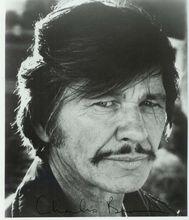 查爾斯·布朗森
查爾斯·布朗森中文名: 查爾斯·布朗森
英文名: Charles Bronson
性 別: 男
生 日: 1921-11-03
角 色:演員,編劇
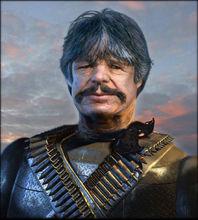 查爾斯·布朗森
查爾斯·布朗森礦工的兒子,在家裡的15個孩子中是唯一念完高中的。二戰期間是轟炸機上的機槍手,退伍後去學習美術,並在一間演出公司當布景設計師,偶爾也演出一些小角色。49年開始在好萊塢的電影和電視劇中演一些壞蛋角色,因情況一直未見好轉.不得已在68年離開美國,轉往歐洲打天下,不料卻成為當地的動作片巨星,代表作有《狂沙十萬里》、《雨中怪客》等。71年還榮獲金球獎的“全球最受歡迎影星”獎座。72年布朗遜衣錦榮歸,主演好萊塢黑邦片《大時代》,兩年後以《猛龍怪客》創造事業巔峰。此片在二十年間一共拍了五部續集之多。在80年代之後,其動作巨星地位被逐漸取代,只能拍一些B級片。2003年8月30日,查爾斯·布朗森因肺炎在洛杉磯一家醫院去世,享年82歲。
Biography for Charles Bronson (資料來自imdb)
Date of Birth
3 November 1921, Ehrenfeld, Pennsylvania, USA
Date of Death
30 August 2003, Los Angeles, California, USA. (pneumonia and Alzheimer's disease)
Birth Name
Charles Dennis Buchinsky
Nickname
Il Brutto (Italy)
Le Sacre Monstre (France)
 中文名:查爾斯·布朗森
中文名:查爾斯·布朗森Height
5' 10" (1.78 m)
Mini Biography
The archetypal screen tough guy with weatherbeaten features - one film critic described his rugged looks as "a Clark Gable who had been left out in the sun too long" - Charles Bronson was born Charles Buchinski, one of 14 children of struggling Polish immigrant parents in Pennsylvania (his father was a coal miner). He completed high school and joined his father in the mines (an experience that resulted in a lifetime fear of being in enclosed spaces) and then served in WW II. After his return from the war, Bronson used the GI Bill to study art (a passion he had for the rest of his life), then enrolled at the Pasadena Playhouse in California. One of his teachers was impressed with the young man and recommended him to director Henry Hathaway, resulting in Bronson making his film debut in You're in the Navy Now (1951). He appeared on screen often early in his career, though often uncredited. However, he made an impact on audiences as the evil assistant to Vincent Price in the 3-D thriller House of Wax (1953). His sinewy yet muscular physique got him cast in action-type roles, often without a shirt to highlight his manly frame. He received positive notices from critics for his performances in Vera Cruz (1954), Target Zero (1955) and Run of the Arrow (1957). Indie director Roger Corman cast him as the lead in his well-received low-budget gangster flick Machine-Gun Kelly (1958), then Bronson scored the lead in his own TV series, "Man with a Camera" (1958). The 1960s proved to be the era in which Bronson made his reputation as a man of few words but much action. Director John Sturges cast him as half Irish/half Mexican gunslinger Bernardo O'Reilly in the smash hit western The Magnificent Seven (1960), and hired him again as tunnel rat Danny Velinski for the WWII POW big budget epic The Great Escape (1963). Several more strong roles followed, then once again Bronson was back in military uniform, alongside Lee Marvin and Ernest Borgnine in the testosterone-filled The Dirty Dozen (1967). European audiences had taken a shine to his minimalist acting style, and he headed to the Continent to star in several action-oriented films, including Bataille de San Sebastian, La (1968) (aka "Guns for San Sebastian"), the cult western C'era una volta il West (1968) (aka "Once Upon a Time in The West"), Passager de la pluie, Le (1969) (aka "Rider On The Rain") and, in one of the quirkier examples of international casting, alongside Japansese screen legend Toshirô Mifune in the western Soleil rouge (1971) (aka "Red Sun"). American audiences were by now keen to see Bronson back on US soil, and he returned triumphantly in the early 1970s to take the lead in more hard-edged crime and western dramas, including The Valachi Papers (1972) and the revenge western Chato's Land (1972). After nearly 25 years as a working actor, he became an overnight sensation. Bronson then hooked up with British director Michael Winner to star in several highly successful urban crime thrillers, including The Mechanic (1972) and The Stone Killer (1973). He then scored a solid hit as a Colorado melon farmer-done-wrong in Richard Fleischer's Mr. Majestyk (1974). However, the film that proved to be a breakthrough for both Bronson and Winner came in 1974 with the release of the controversial Death Wish (1974) (written with Henry Fonda in mind, who was disgusted by the script). The US was at the time in the midst of rising street crime, and audiences flocked to see a story about a mild-mannered architect who seeks revenge for the murder of his wife and rape of his daughter by gunning down hoods, rapists and killers on the streets of New York City. So popular was the film that it spawned four increasingly inferior sequels over the next 20 years.
Action fans could not get enough of tough guy Bronson, and he appeared in what many fans, and critics, consider his best role - as Depression-era streetfighter Chaney alongside James Coburn in the superb Hard Times (1975). That was followed by the somewhat slow-paced but beautifully photographed western Breakheart Pass (1975) (with wife Jill Ireland), the light-hearted romp (a flop) From Noon Till Three (1976), and as Soviet agent Grigori Borsov in director Don Siegel's decent Cold War thriller Telefon (1977). Bronson remained busy throughout the 1980s, with most of his films taking a more violent tone, and he was pitched as an avenging angel eradicating evildoers in films like the mediocre 10 to Midnight (1983), the nearly unwatchable The Evil That Men Do (1984), Assassination (1987) and Kinjite: Forbidden Subjects (1989). Bronson jolted many critics with his forceful work as murdered United Mine Workers leader Jock Yablonski in the TV movie Act of Vengeance (1986) (TV), gave a very interesting performance in the Sean Penn-directed The Indian Runner (1991), and surprised everyone with his appearance as compassionate newspaper editor Francis Church in the family film Yes Virginia, There Is a Santa Claus (1991) (TV).
Bronson's final film roles were as police commissioner Paul Fein in a well-received trio of crime/drama TV movies Family of Cops (1995) (TV), Breach of Faith: Family of Cops II (1997) (TV) and Family of Cops III: Under Suspicion (1999) (TV). Unfortunately, ill health began to take its toll; he suffered from Alzheimers disease for the last few years of his life, and finally passed away from pneumonia at Los Angeles' Cedars-Sinai Medical Center in August 2003. Bronson was a true icon of international cinema; critics had few good things to say about his films, but he remained a fan favorite in both the US and abroad for 50 years, a claim few other film legends can make.
Spouse
Kim Weeks (22 December 1998 - 30 August 2003) (his death)
Jill Ireland (5 October 1968 - 18 May 1990) (her death) 1 daughter
Harriet Tendler (1949 - 1967) (divorced) 2 children
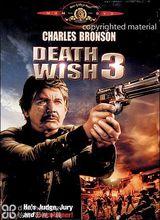 查爾斯·布朗森的劇照
查爾斯·布朗森的劇照Trivia
Shared a room with Jack Klugman in a New York boarding house in the 1940s.
He had two children with his first wife, Tony and Suzanne. He then married Jill Ireland, who had two sons with her first husband, David McCallum. One adopted son (Jason) died in 1989. He and Ireland had a daughter named Zuleika.
Perhaps the biggest late bloomer in Hollywood history, he did not get the marquee treatment he deserved until his late 40s. He was already 53 when Death Wish (1974) premiered.
The name Bronson is said to taken from the "Bronson Gate" at Paramount Studios, at the north end of Bronson Avenue.
Spoofed in an episode of "The Simpsons" (1989) in which the Simpson family mistakenly travels to Bronson, Missouri, instead of Branson. In Bronson, such lines of dialogue as these are spoken by its citizens: "No dice.", "This ain't ovah."
Changed his stage name in the early 1950s in the midst of the McCarthy "Red Scare" at the suggestion of his agent, who was fearful that his last name (Buchinsky) would damage his career.
Actor Dick Van Dyke received a lemon cake every Christmas from Bronson, who lived nearby in Malibu for 16 years
In 1949 he moved to California, where he signed up for acting lessons at the Pasadena Playhouse
In 1954 on the Mexican set of Vera Cruz (1954), he and fellow cast member Ernest Borgnine--who were playing American gunfighters involved in the Mexican fight against the French--had some spare time on their hands and decided to go to a nearby town for cigarettes. They saddled up in costume, sidearms and all, and began riding to town. On the way they were spotted by a truck full of Mexican "federales"--national police--who mistook them for bandits and held them at gunpoint until their identities could be verified.
Was drafted into the army in 1943 and assigned to the Air Corps. At first he was a truck driver, but was later trained as a bomber tail gunner and assigned to a B-29. He flew 25 missions and received, among other decorations, a Purple Heart for wounds incurred in battle.
"I am not a Casper Milquetoast," Bronson told The Washington Post in 1985, recalling the time he was visiting Rome and felt someone stick a gun in his side. "A guy in broken English asked me for money. I said, 'You give ME money.' He turned around and walked away."
Director John Huston once summed him up as "a grenade with the pin pulled"
Was by all accounts a very quiet and introspective collaborator, often sitting in a corner for much of a shoot and listening to a director's instructions and not saying a word until cameras were rolling.
Was the first actor considered for the role of Snake Plissken in Escape from New York (1981)
He grew privately frustrated by the declining quality and range of roles over his career, being pigeonholed as a violent vigilante after the commercial success of Death Wish (1974). His own favorite of his "vigilante" movies was C'era una volta il West (1968) (aka Once Upon a Time in the West).
In 1963 Sergio Leone asked him to star in his western Per un pugno di dollari (1964) (A Fistful of Dollars). Bronson turned the role down, so Leone asked Clint Eastwood.
His father died when he was 10, and at 16 he followed his brothers into the mines to support the family. He was paid $1 per ton of coal and volunteered for perilous jobs because the pay was better.
Responding to critics' complaints, he said: "We don't make movies for critics, since they don't pay to see them anyhow."
Called West Windsor, Vermont his home for more than three decades (Bronson Farm), and was buried in nearby Brownsville Cemetery, near the foot of Mt. Ascutney.
Appeared with Steve McQueen and James Coburn in two films, both of which were directed by John Sturges: The Magnificent Seven (1960) and The Great Escape (1963).
With his death on August 30, 2003, Robert Vaughn and Eli Wallach are the only two of the seven main stars of the The Magnificent Seven (1960) who are still alive as of November 2005.
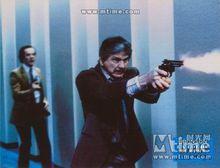 《暴力先鋒》劇照
《暴力先鋒》劇照His stepson, Jason McCallum Bronson, the adoptive son of David McCallum and Jill Ireland, died of an accidental drug overdose in 1989.
Was introduced to his second wife, Jill Ireland, by her then-husband David McCallum during the filming of The Great Escape (1963).
Spoke fluent Russian, Lithuanian and Greek.
Owned homes in Europe, including Lithuania and Greece.
Had hip replacement surgery in August 1998.
The voice of the sarcastic store clerk in "The Simpsons" (1989) is based on him.
Sergio Leone once called him "the greatest actor I ever worked with". Leone had wanted Bronson for all three of what became known as the "Man with No Name" trilogy, but Bronson turned him down each time.
The term "Charles Bronson" is frequently uttered in Reservoir Dogs (1992) in reference to a hard-man.
He was very active in raising funds for the John Wayne Cancer Institute.
Advertised Mandom hair oil.
Capable of essaying a variety of types, from Russian to American Indian, from homicidal villain to tight-lipped hero, Bronson suddenly became a star at the age of 50. Following the success of Death Wish (1974) he repeated, with little variation, his role as a vengeful urban vigilante.
In the latter part of his career, he worked predominantly with The Guns of Navarone (1961) director J. Lee Thompson. They made nine films together in just over a decade between 1977 and 1989: 10 to Midnight (1983), Caboblanco (1980), Death Wish 4: The Crackdown (1987), The Evil That Men Do (1984), Kinjite: Forbidden Subjects (1989), Messenger of Death (1988), Murphy's Law (1986), St. Ives (1976) and The White Buffalo (1977).
From a Lithuanian family, he grew up in a western Pennsylvania coal-mining town. Like all the men in his family, he worked in the mines, but hated it and used a variety of means to escape it (including the military and, eventually, acting). His expertise with tunneling and working underground turned out to be quite helpful when making The Great Escape (1963) in the role of "Tunnel King" Velinski. However, even though the "tunnel" he was working in was a cutaway set, he could only stay in it for a few minutes at a time before he had to get up and leave. As a boy working in the mines, he was caught in a cave-in and almost died before he was finally rescued. Ever since that time he had had a deathly fear of enclosed spaces.
Made six films with director Michael Winner: Chato's Land (1972), The Mechanic (1972), The Stone Killer (1973), Death Wish (1974), Death Wish II (1982) and Death Wish 3 (1985).
In the '90s a lady whom he'd never met left him her estate worth well over a million dollars. She was a big fan of his. Her family sued and he ended up settling with them out of court.
Diagnosed with Alzheimer's disease in 2000 after suffering ill health for the previous two years.
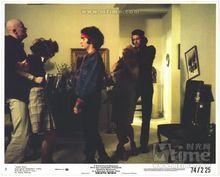 《猛龍怪客》劇照
《猛龍怪客》劇照Retired from acting after undergoing hip replacement surgery in 1998.
The Japanese manga artist Yoshiyuki Okamura, famed for the Fist of the Northstar manga sometimes credit himself under the name of Buronson, after Bronson and sports a similar moustache.
He and his wife Jill Ireland adopted Katrina Holden Bronson after her mother Hilary Holden died in 1983.
Personal Quotes
"I guess I look like a rock quarry that someone has dynamited."
"Acting is the easiest thing I've done, I guess that's why I'm stuck with it."
"Someday I'd like a part where I can lean my elbow against a mantlepiece and have a cocktail."
"I don't look like someone who leans on a mantelpiece with a cocktail in my hand, you know. I look like the kind of guy who has a bottle of beer in my hand."
"Maybe I'm too masculine. Casting directors cast in their own, or an idealized image. Maybe I don't look like anybody's ideal." (1971)
"I am not a fan of myself."
Nobody stays on top forever. Nobody!
Salary
10 to Midnight (1983) $2,000,000
Death Wish (1974) $1,000,000
Valdez, il mezzosangue (1973) $1,000,000
The Stone Killer (1973) $1,000,000
翻譯:
傳為查理士布朗遜(資料來自imdb )
出生日期
1921年11月3日, ehrenfeld , Pennsylvania ,美國
死亡日期
2003年8月30日,洛杉磯,美國加利福尼亞州。 (肺炎和阿爾茨海默病)
出生名稱
查爾斯丹尼斯buchinsky
暱稱
白細胞介素brutto (義大利)
樂聖monstre (法國)
高度
5 ' 10 “ ( 1.78米)
共用一個房間:與傑克klugman在一個新的紐約寄宿眾議院在20世紀40年代。
他生了兩個孩子,與第一任妻子,托尼和蘇珊。然後,他已婚,小傑愛爾蘭,誰有兩個兒子,與第一任丈夫,戴維麥考倫。一養子(傑森) 1989年去世。他和愛爾蘭了一個女兒命名為zuleika 。
也許最大的晚bloomer在好萊塢的歷史,他沒有得到治療的肩上,他當之無愧,直到他40多歲的晚期。他已53時,死亡的希望( 1974 )首演。
名稱布朗森表示,採取從“布朗森門”在派拉蒙製片廠,在北端的布朗森的途徑。
欺騙性在一集“辛普森一家” ( 1989年) ,其中辛普森家庭誤前往布朗森,密蘇里,而不是布蘭森。在布朗森,如線的對話,因為這些發言,其公民說: “沒有骰子” , “這不是ovah ” 。
改變了他的藝名在1950年代初在中的麥卡錫的“紅色恐慌”的建議,他的經紀人,誰是害怕,他的姓氏( buchinsky )會損害他的職業生涯。
演員迪克范戴克收到了檸檬蛋糕,每個聖誕節,從布朗森,誰住在附近的馬里布16年
在1949年,他移居加州,他在那裡簽署了為署理教訓,在帕薩迪納劇場
在1954年對墨西哥的一套維拉克魯斯( 1954年) ,他和同胞投下會員歐內斯特博格寧-誰玩美國g unfighters涉及在墨西哥打擊法語-有一些閒暇時間對他們的手中,並決定到一個附近城市的香菸。他們背負了在服裝, sidearms和所有,並開始騎馬城市。就未來路,他們發現一輛卡車,充滿墨西哥“ federales ” -國家警察-誰誤以為他們為土匪和舉行他們在槍口下,直到他們的身份可以得到證實。
草擬入軍隊在1943年分配到空軍。起初他是一名卡車司機,但後來的訓練作為一個轟炸機尾炮手和分配到的B - 29 。他飛到25項任務,並收到,除其他外裝飾,紫心勳章,為傷口而招致的戰役。
“我不是一個卡斯帕爾milquetoast , ”布朗森告訴華盛頓郵報在1985年,回顧的時間,他訪問羅馬,並認為有人堅持用槍在他身邊。 “你想想,在打破英語問我要錢,我說, '你給我錢。他回過頭和走開“ 。
導演約翰休斯頓,一旦他總結為“投擲一枚手榴彈,與銷拉動”
是由所有帳戶的一個非常安靜的和反省的合作者,經常坐在角落裡的大部分拍攝,並聽取了董事的指示,和不說一句話,直到照相機滾動。
是第一個演員考慮的作用,蛇, plissken在逃生由New York ( 1981 )
他長大私人沮喪下降的質量和範圍的角色,超過他的職業生涯,正在pigeonholed作為一個暴力民後,商業上的成功死亡的希望( 1974年) 。他自己最喜愛他的“民”電影是c'era聯合國協會沃爾特金正日西( 1968年) (又名黃飛鴻的時間在西部地區) 。
在1963年塞爾吉奧的籌措問他,以星在他的西方%聯合國pugno邸dollari ( 1964年) (一fistful美元) 。布朗森,把角色,所以籌措問克林特伊斯特伍德。
他的父親去世時,他是10和16 ,他隨後他的兄弟到地雷,以支持家庭。他支付了1元,每噸煤和自願危險的工作,因為薪酬是更好。
回應批評者的投訴,他說: “我們不作電影的批評,因為他們不支付看到他們無論如何” 。
所謂的西溫莎,佛蒙特他家三年多十年(布朗森農場) ,以及被掩埋在附近的布朗斯維爾墳場,附近的山山腳。 ascutney 。
出現了與史蒂夫麥奎因和詹姆斯coburn在兩部電影,兩者都是針對由約翰斯特奇斯:宏偉七( 1960年)和大逃亡( 1963年) 。
與他的逝世對2003年8月30日,羅伯特沃恩和禮Wallach和是唯一的兩個七項主要星級的宏偉七( 1960年)誰仍然活著,截至2005年11月。
他stepson ,賈森麥考倫布朗森,收養的兒子大衛麥考倫和小傑愛爾蘭,死於意外藥物過量在1989年。
介紹了他的第二任妻子,小傑愛爾蘭,她當時的丈夫大衛麥考倫在拍攝大逃亡( 1963年) 。
以一口流利的俄語,立陶宛和希臘。
國有家園在歐洲,包括立陶宛和希臘。
曾髖關節置換手術在1998年8月。
聲音的風涼話商店售貨員在“辛普森一家” ( 1989年)是基於他。
塞爾吉奧的籌措後,稱他為“最大的演員是我的工作” 。籌措原本想布朗森為所有三個什麼樣的,成為被稱為“男子沒有名字的”三部曲,但布朗森使他每一次下跌。
術語“查理士布朗遜”是經常說出了在水庫狗( 1992 )在參考一硬的人。
他是非常積極籌集資金,為約翰韋恩癌症研究所。
廣告mandom頭髮油。
能夠essaying多種類型,從俄羅斯到美洲印第安人,從殺人的惡棍,以守口如瓶英雄,布朗森突然成為明星,在年滿50歲。繼成功死亡的希望( 1974年) ,他重複,幾乎沒有變化,他的作用,作為報復城市治安。
在後者的一部分,他的職業生涯,他的工作主要是與槍的navarone ( 1961年)主任李篤湯普森。他們提出的9電影一起在剛剛超過十年之間, 1977年和1989年: 10至午夜十二時( 1983年) , caboblanco ( 1980年) ,死亡希望4 :打擊( 1987年) ,邪惡的男人做( 1984 ) , kinjite :禁止科目( 1989年) ,信使的死亡( 1988年) ,墨菲的法律( 1986年) ,聖艾夫斯( 1976年)和白色水牛( 1977年) 。
來自立陶宛的一個家庭,他成長於一個西方賓夕法尼亞州的煤炭開採城市。象所有的男子在他的家人,他在地雷,但討厭它,並採用了各種手段來逃避它(包括軍事,並最終署理) 。他的專業知識與隧道和地下的工作,原來是相當有幫助時,大逃亡( 1963年)中的作用“隧道國王” velinski 。不過,即使“隧道”他是在工作是一個剖集,他只能留在它為數分鐘,在一個時間之前,他不得不站起來離開。作為一名男童工作,在礦山,他被抓獲在一個洞穴中,幾乎死亡之前,他終於獲救。以往任何時候都自那時以來他不得不一deathly的恐懼封閉空間。
取得了6電影與導演麥可冠軍: chato的土地( 1972年) ,機械( 1972年) ,石殺手( 1973 ) ,死亡想( 1974年) ,死亡想二( 1982年)和死亡的希望三( 1985年) 。
在九十年代,一位他從未見過的要離開他她的地產價值,以及超過100萬美元。她是一大范他。她的家人起訴及他結束了與解決他們走出法院。
診斷與阿爾茨海默病的在2000年後的痛苦健康欠佳為前兩年。
退休後,署理經歷髖關節置換手術在1998年。
日本的漫畫藝術家義岡村,著名的為拳頭的northstar漫畫,有時信貸自己的名義下, buronson後,布朗森和體育類似的鬍子。
他和他的妻子吉爾愛爾蘭通過卡特里娜霍爾登布朗森後,她的母親希拉蕊霍爾登死亡,在1983年。
薪金:
10日至午夜十二時( 1983年)為2,000,000元
死亡的希望( 1974 ) $ 1,000,000
瓦爾迪茲,白細胞介素mezzosangue ( 1973 ) $ 1,000,000
石殺手( 1973 ) $ 1,000,000
主要作品
1951年 You're in the Navy Now
1951年 《紐約警探網》(The People Against O'Hara)
1951年 《暴徒》(The Mob)
1952年 《婚姻趣事》(The Marrying Kind)
1952年 《我的六人罪犯》(My Six Convicts)
1952年 《帕特和麥克》(Pat and Mike)
1952年 Red Skies of Montana
1952年 《諜影雄風》(Diplomatic Courier)
1952年 《百老匯偵探》(Bloodhounds of Broadway)
1952年 《丑角》(The Clown)
1952年 《戰爭地帶》(Battle Zone)
1953年 Off Limits
1953年 Torpedo Alley
1953年 《恐怖蠟像館》(House of Wax)
1953年 《軍中紅》(Miss Sadie Thompson)
1953年 《龍虎干戈》(Vera Cruz)
1954年 《警網重重》(Crime Wave)
1954年 《鐵腕丹心》(Tennessee Champ)
1954年 《馬背上的槍聲》(Riding Shotgun)
1954年 《草莽雄風》(Apache)
1954年 《雷鳴戰鼓》(Drum Beat)
1955年 Big House, U.S.A.
1955年 Target Zero
1956年 《遠走高飛 》(Jubal)
1957年 《執導》(Run of the Arrow)
1958年 Gang War
1958年 《機槍手凱利》(Machine-Gun Kelly)
1958年 Showdown At Boot Hill
1958年 When Hell Broke Loose
1959年 《戰雲》(Never So Few)
1960年 《豪勇七蛟龍》(The Magnificent Seven)
1961年 《世界的主人》(Master of the World)
1961年 A Thunder of Drums
1961年 《碧血長空》(X-15)
1962年 《長勝拳王》(Kid Galahad)
1963年 《大逃亡 》(The Great Escape)
1963年 《德州四傑》(4 for Texas)
1965年 《坦克大決戰 》(Battle of the Bulge)
1965年 《春風無限恨》(The Sandpiper)
1965年 Guns of Diablo
1966年 《蓬門碧玉紅顏淚》(This Property Is Condemned)
1967年 《十二金剛》(The Dirty Dozen)
1968年 《雙虎將大追蹤》(Guns for San Sebastian)
1968年 《朋友再見》(Farewell, Friend)
1968年 Villa Rides
1968年 《西部往事》(Once Upon a Time in the West)
1969年 《蘿拉》(Lola)
1969年 《雨中的乘客》(Rider on the Rain)
1970年 《大風暴》(You Can't Win 'Em All)
1970年 《狼之輓歌》(Violent City)
1970年 Cold Sweat
1971年 《致命動機》(Someone Behind the Door)
1971年 《龍虎群英》(Red Sun)
1972年 《野狼》(Chato's Land)
1972年 《大時代》(The Valachi Papers)
1972年 《龍虎鐵金剛》(The Mechanic)
1973年 《鐵石殺手》(The Stone Killer)
1973年 Chino
1974年 《猛龍鐵金剛 》(Mr. Majestyk)
1974年 《猛龍怪客》(Death Wish)
1975年 《最後逃亡》(Breakout)
1975年 《奪命列車》(Breakheart Pass)
1975年 《鬥士》(Hard Times)
1976年 《老查的故事》(From Noon Till Three)
1976年 《出奇制勝》(St. Ives)
1977年 《威馬神龍 》(The White Buffalo)
1977年 《火狐一號出擊》(Raid on Entebbe)
1977年 《霹靂大火拚》(Telefon)
1979年 《火爆猛金鋼》(Love and Bullets)
1980年 《地獄天堂》(Borderline)
1980年 《布蘭科角》(Caboblanco)
1981年 《雪嶺過江龍》(Death Hunt)
1982年 《猛龍怪客2》(Death Wish II)
1983年 《處刑在午夜》(10 to Midnight)
1984年 《手下不留情》(The Evil That Men Do)
1985年 《猛龍怪客3》(Death Wish 3)
1986年 《暴力先鋒》(Murphy's Law)
1987年 《暗殺第一夫人》(Assassination)
1987年 《猛龍怪客4》(Death Wish 4: The Crackdown)
1988年 《閻王信差》(Messenger of Death)
1989年 《近距對搏》(Kinjite: Forbidden Subjects)
1991年 《兄弟情仇》(The Indian Runner)
1994年 《猛龍怪客5》(Death Wish V: The Face of Death)
人物評價
“我猜我看起來不像岩石石礦場有人dynamited ” 。
“署理是最容易的事我已經做了,我猜想這就是為什麼我一直堅持它” 。
“總有一天,我想要的一部分,如果我可以精益我的肘部對mantlepiece ,並有雞尾酒” 。
“我並不像有人誰傾斜就一mantelpiece與酒會,在我的手,你知道,我想看看什麼樣的傢伙誰擁有了一瓶啤酒,在我的手” 。
“也許我太男性化。鑄造董事投在自己的,或一個理想化的形象,也許我不喜歡看任何人的理想” 。 ( 1971年)
“我不是一個范自己” 。
沒有人停留在頂端永遠。沒有人!
盤點美國知名電影演員
| 本期任務盤點美國知名電影演員,完善人物正文內容,創建網站未收錄詞條。添加摘要,信息模組,相關詞條,客觀分類。 |
